The Acer Swift 3 SF314 Notebook Review: Swift Gets Swifter With Ryzen 4000
by Brett Howse & Andrei Frumusanu on May 5, 2020 8:00 AM ESTBattery Life
While AMD’s rebirth in the notebook market brought with it some changes that have shaken up the laptop market, one area where AMD’s Ryzen APUs have suffered is in terms of battery life. Thanks to a high base power draw, both the AMD Ryzen 2000 and 3000 series could not match the competition in terms of outright battery life. With the new Ryzen 4000 series, AMD has not only moved to the Zen 2 CPU cores, but also to the 7 nm TSMC process, so they should have a chance to rectify their previous shortcomings.
Despite the 14-inch notebook size, the Acer Swift 3 ships with just a 48 Wh battery, which is much smaller than you would see as an average for this size of device. Of course battery capacity is only one side of the equation, with the other being power draw, so to test the overall battery life the notebook was run through our laptop battery suite, which consists of a low-impact web test, a high-impact web test, and movie playback from a local file. As always, the display is set to 200 nits of brightness to normalize display power across all of the notebooks.
Light Battery Life
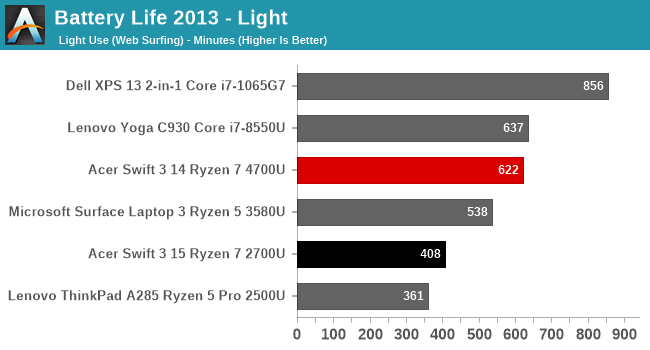
The Acer Swift 3 does quite well in our lightest test, offering over ten hours of screen-on time. A great comparison is the Microsoft Surface Laptop 3 15-inch, which had Picasso and a battery of similar capacity.
Web Battery Life
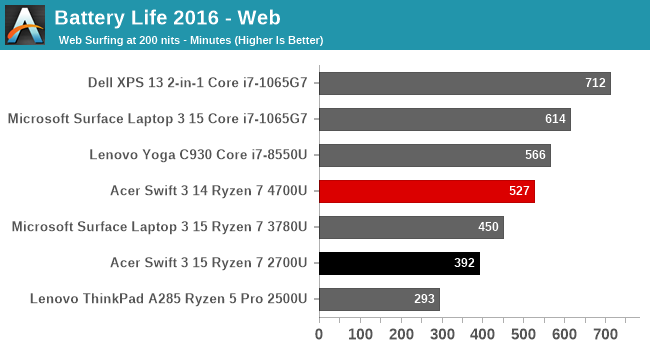
Our revamped web test is much more demanding on the CPU, and generally especially impacts thin and light designs where the base power draw is quite low. That is the case here, with almost 100 minutes less runtime than the light battery test. But the results are still encouraging, with almost nine hours of runtime.
Movie Playback
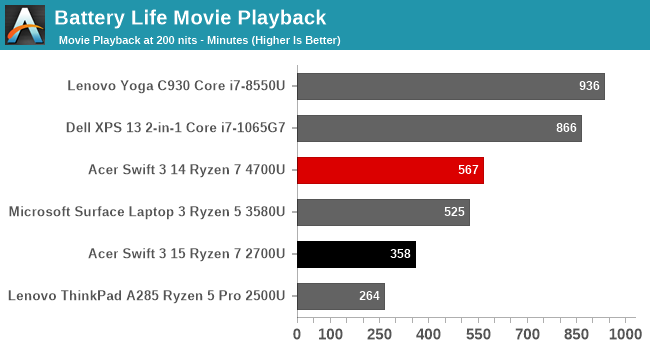
The Acer Swift 3 offers good battery life with the movie playback as well, closing in on ten hours straight with the display at 200 nits brightness. This is one area where the previous AMD APUs struggled, since it does mean offloading the video decode to the GPU. Intel has incredibly efficient hardware blocks dedicated to this, and the AMD APU can’t quite match that, but is still an improvement over Picasso.
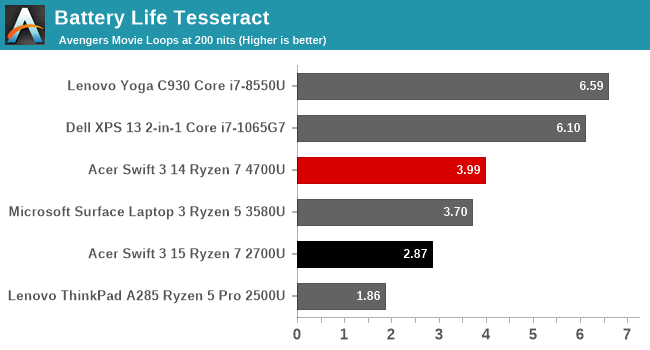
In terms of overall movie playback time, the Acer Swift 3 would let you watch four complete sittings of The Avengers in a row, although you’d miss the end of the credits in the final loop.
Normalized Battery Life

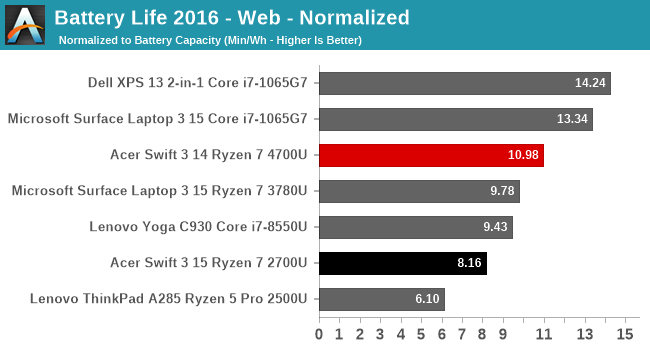
Removing the battery size from the battery life equation lets us take a look at platform efficiency across the different notebooks. In our light test, there is a big jump in efficiency when comparing to the Microsoft Surface Laptop 3 AMD edition, and as the light test is mostly an idle scenario, gives hope that Renoir has finally solved AMD’s extra power draw. The Web test is more demanding, meaning more CPU power is used, and only shows a small gain over the previous generation.
Platform Power Draw
To get an idea how much power draw there is on the new Renoir based platform, we turned to BatteryBar Pro to log the power draw. The results were impressive. AMD has more or less matched Intel in terms of idle power usage with their Ryzen 4000 series.
The first-generation Acer Swift 3 with Ryzen 5 2500U drew around 2.55 watts at idle, but the new Ryzen 7 4700U Acer Swift 3 idled right around 1.0 Watts, matching the 10th generation Intel Ice Lake equipped Surface Laptop 3. This is a big step for AMD, and allows them to compete not just on performance, but battery life as well.
Battery Life Conclusion
Despite the smaller than average 48 Wh battery capacity, the updated Ryzen 7 4700U in the Acer Swift 3 manages to provide solid battery life. This is a big win for AMD, where battery life was one of the key drawbacks to their previous Ryzen APUs. With right around 1.0 Watts of idle power draw with the screen off, they are no longer playing catch-up to the competition. For light tasks, it should easily get through the day.
Charge Time
Acer includes a 65-Watt A/C adapter with the Swift 3, providing more than enough output to power this laptop. As previously mentioned though, the included connector is a barrel connector, which in itself is not a huge issue, except that Acer’s barrel connectors are very thin and would be prone to breaking. This has been a concern on their notebooks for some time. The good news is that the notebook also has a USB-C connector with power delivery, and you can charge the laptop over USB-C with no issues. Despite the convenience, USB-C is still an expensive standard, so some vendors have not made the switch on all of their devices yet.
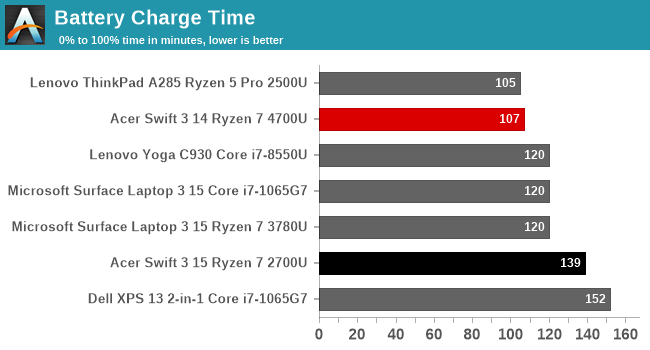
As far as charge time, the 65-Watt charger makes short work of the battery, charging the laptop up to maximum in under two hours. The charge rate peaks around 30 Watts, and Acer claims you can charge four hours of battery usage in 30 minutes of charge time.


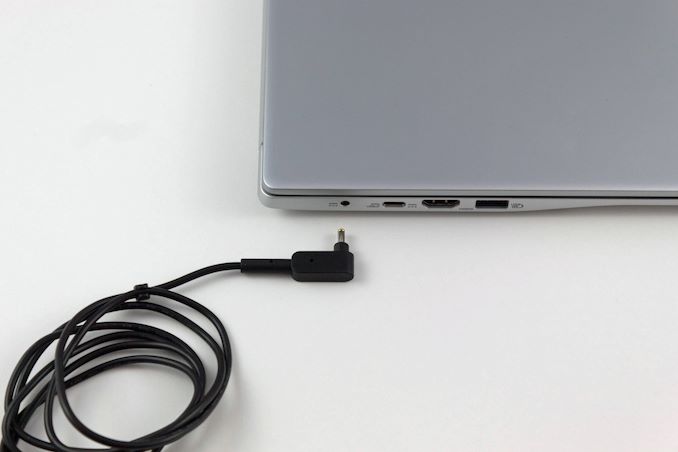








191 Comments
View All Comments
neblogai - Tuesday, May 5, 2020 - link
If you are interested in such things- check this video about the same laptop: https://youtu.be/awPI4RzKMvY?t=386 (use autotranslate). Basically- he put a thermal pads on the heatpipe so it transfers heat to the aluminum back cover. This allowed higher Cinebench result from cold and also higher and more consistent results in Cinebench loop. Before this modification- two of the 30 CB results were ~10% and 7% lower than others (4:40), while after the modding- all scores were higher, and without drops. Also- with this modification, bottom obviously got warmer, so this is not a solution for everyone.eastcoast_pete - Tuesday, May 5, 2020 - link
Thanks, that is an interesting review and modification. As you stated, the reviewer mentioned (assuming I can trust Google translate of the captioning) that this simple addition of thermal pads reduced the erratic thermal throttling a lot, and how little it would add to the BOM costs. Too bad Acer hasn't taken him up on his suggestion! I would pay an extra $5 for that; it's well worth it.anonomouse - Tuesday, May 5, 2020 - link
Any chance of memory latency and memory bandwidth comparison charts between the machines used in the SPEC2017 page? Would be interesting/useful to see these charts taking into account the performance on memory bound workloads, even if the Ice Lake part is using LPDDR4 and not DDR4 like the other two.wordlv - Tuesday, May 5, 2020 - link
Xps 13 runs @25w. This is known fact!hanselltc - Tuesday, May 5, 2020 - link
What the hell is the laptop doing with its thermal management? The SoC Temp FC5 just doesn't match up with the wattage it is drinking. Is the fan curve bad? Does the chip just flips out when it needs to balance CPU and iGPU powerdraw while it is hovering around the hard throttle temp limit?eastcoast_pete - Tuesday, May 5, 2020 - link
I found that link posted by neblogai a few comments up really informative! Apparently, Acer left a lot of potential, yet straightforward heat dissipation on the table.Hulk - Tuesday, May 5, 2020 - link
AMD is obviously on a roll but looking at these Ice Lake results I'd say Intel ain't dead yet. We have a fight on our hands!watzupken - Wednesday, May 6, 2020 - link
"AMD is obviously on a roll but looking at these Ice Lake results I'd say Intel ain't dead yet. We have a fight on our hands!"Firstly, I don't think it is a good comparison between a top end laptop running the top end Intel Ice Lake chip, and this low end Swift 3, running a mid high end Renoir chip. Top end laptops normally put in more care when it comes to cooling, and I believe this Dell model may be using a dual fan cooling solution despite its small and slim size. The cooling will certainly help improve sustained and burst performance, which in turn affect the benchmark scores. From my experience, Acer Swift 3 typically employs a single fan, single heatpipe cooling solution, which is woefully poor in cooling. If you look at some reviews out there on Ice Lake performance on lower end laptops, you noticed that the sustained clockspeed can go below 2Ghz, which will certainly hurt performance.
Secondly spec wise, the i7 and faster RAMs on the Dell will also give it an edge, against the Ryzen 7 4700U with slower RAM.
In this case, just as the review pointed out in the thermal section, I feel the Ryzen 7 4700U is actually very thermally limited to show its full potential. Hopefully we see other PC makers/ models that will provide better cooling.
Oxford Guy - Thursday, May 7, 2020 - link
Yes, if you limit the AMD chip to 8 watts:"The laptop really struggled with its thermals, dropping the framerate into single digits often. The device attempted to run at around 18 Watts of power draw, slightly over the 15 Watt TDP, but in fact only averaged around 8 Watts during this run."
supdawgwtfd - Tuesday, May 5, 2020 - link
"channels if your router is has the correct capabilities."Wanted! Proof reader/editor.